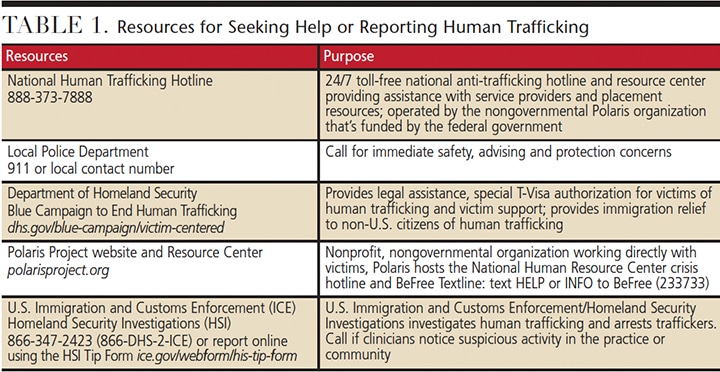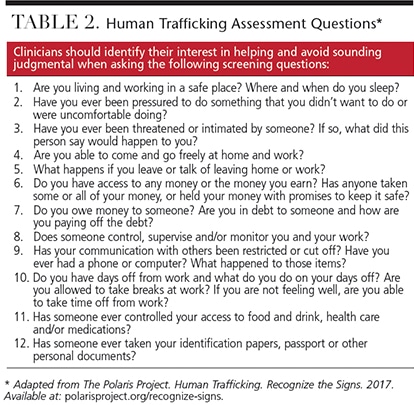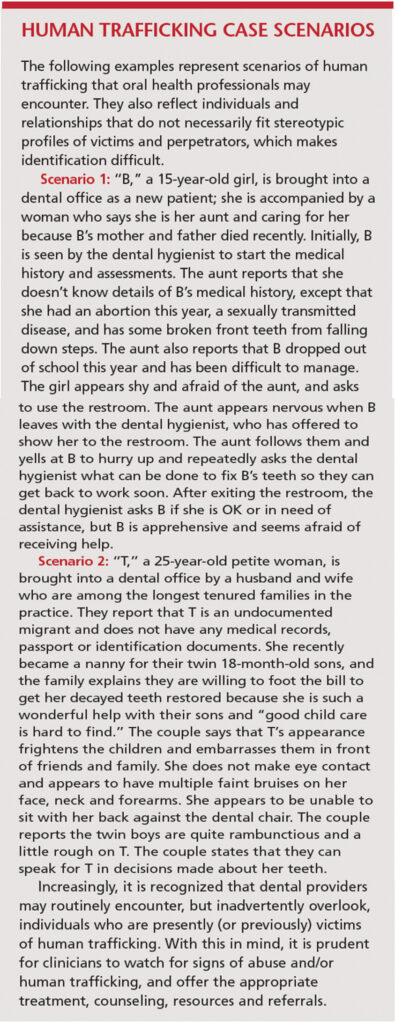
Human Trafficking: Red Flags for Dental Professionals
Dentists and dental hygienists should look for the subtle signs of victimization so they can offer appropriate treatment, resources and referrals.
This course was published in the August 2017 issue and expires August 2020. The authors have no commercial conflicts of interest to disclose. This 2 credit hour self-study activity is electronically mediated.
OBJECTIVES
After reading this course, the participant should be able to:
- Discuss trends in human trafficking, and oral health professionals’ role in identifying, treating and helping victims.
- Explain the types of individuals that human traffickers target, and tactics for manipulating victims.
- Describe common oral injuries that trafficking victims present with, as well as reasons why victims typically underreport abuse.
Human trafficking is a rampant global health problem affecting a growing number of children and adults. On a worldwide basis, traffickers use fraud, coercion, threats and deception to manipulate victims into various forms of exploitation, including domestic servitude, sex trafficking, sham marriages, forced labor and criminal activity. Trafficking is identified as a form of slavery and a major, yet often hidden, crime involving the control of victims for the traffickers’ economic gain.1 Targeting potential victims who appear lost, disenfranchised or in desperate situations, traffickers are adept at isolating victims from social support systems and creating dependency, limiting victims’ movement to work settings, and hiding the red flags and signs of victimization. Victims are often lured by promises of lucrative employment, stability, ability to obtain an education, a steady income to send home to support their families, or a loving relationship — some or all of which represent opportunities absent in the victim’s life.2
While the stories of trafficked survivors often include accounts of trying to improve their lives or that of their families, and desires to migrate to areas that promise a better future, these individuals are not always migrants. Although transportation may be a control tactic to keep human trafficking victims in unfamiliar places, the defining characteristic is exploitation for profit, rather than being moved from one region to another.1,3 Given the extent of the problem and fact that trafficked individuals may seek dental treatment, oral health professionals have a responsibility to recognize the signs that may indicate victimization, and be prepared to provide appropriate treatment, resources and referrals (Table 1).
The United States is a key source, site of transport and destination for trafficked individuals.1 Reports of trafficking to the National Human Trafficking Hotline and Polaris BeFree Textline have been increasing in all 50 states and Washington, D.C. The National Human Trafficking Hotline is partially funded by the U.S. Department of Health and Human Services and is operated by Polaris, a nonprofit, nongovernmental anti-trafficking organization. While a lack of uniformity in reporting4 and tracking victims in a universal database, as well as the clandestine nature of this criminal activity, creates challenges in identifying victims, the U.S. Department of State estimates more than 26 million individuals are subjected to human trafficking worldwide.1 As regional and global markets increase for human trafficking, so, too, does the need to identify trafficked individuals. Considering that health care providers may be among the few professionals to come in contact with these individuals, it behooves clinicians to be prepared to identify possible victims.
TRAFFICKING TARGETS
Labor trafficking victims are most often recruited through a job offer and represent approximately 11% percent of our nation’s victims, while sex trafficking accounts for 82% of victims in the U.S.; of the latter, most are trafficked by their intimate partners.5 In 2016, an estimated one out of six of the 18,500 runaway children reported to the National Center for Missing and Exploited Children were likely sex trafficking victims.6 Children are often targeted through social networking and escort websites, and at bus and truck stops, train stations, youth centers, homeless shelters, schools and malls — often within hours of displacement from their homes.2,7,8 Youth entrapment and enmeshment schemes are frequently used in sex trafficking of minors and resemble power and control techniques observed in other exploitive relationships, such as intimate partner violence (IPV), in which there are similarities in the victim and perpetrator dynamics.9
In both child sex trafficking and IPV, the trafficker or perpetrator gain control by isolating victims from outside social support and terrorize victims through the use of emotional blackmail and/or physical and sexual violence.9 Glamorizing and normalizing commercial sex are additional ways adolescents are enticed into sex trafficking, often by traffickers’ use of peers for recruiting. This may include peer recruiters who appear to be living the good life. Pervasive themes in the literature indicate that a female’s age is her greatest vulnerability to being sex trafficked as a minor. Vulnerable populations include children in the child welfare system and foster care, runaways, homeless individuals, individuals living in impoverished communities seeking work, migrant workers, persons with limited English skills, persons with disabilities, socially marginalized individuals, persons rooted in vulnerability to gender inequality situations, and persons who identify as lesbian, gay, bisexual, transgender or intersex.1–4,8,10–15 Increasingly, reports indicate that traffickers are preying on those with intellectual or other disabilities and using drugs or withholding medication and health care to manipulate victims into commercial sex.1,7,14 Branding and tattooing are common, and mark the trafficked person as property, enabling the trafficker to claim ownership of the victim and signal other pimps to stay away.
CHALLENGES IN IDENTIFYING VICTIMS
Identifying victims poses a significant challenge to researchers and professionals who provide medical or dental care, interventions and refer resources because trafficked children and adults rarely self-identify. Trafficked victims may underreport because they:2,3
- Lack access to legal or support services
- Fear retaliation from their traffickers against them or their family
- Have been conditioned to fear and distrust anyone other than their captors, including law enforcement or other authorities
- Fear the consequences of being identified as illegal immigrants or criminals, instead of victims
- Feel ashamed of their activities and how their families and communities will receive them if they return
- Feel a sense of hopelessness in escaping their captor, and the emotional or financial indebtedness employed by their controlling trafficker
- Do not identify that they are being trafficked
PSYCHOLOGICAL AND PHYSICAL COSTS
Traffickers use intimidation and emotional entrapment to control victims, including violence against the individual or their family and friends, threats of deportation, confiscation of identification documents, shaming or guilt, and trauma-bonding (in which the trafficked person fears the trafficker, yet feels relieved to be taken care of, offered employment and allowed to live). Trafficked individuals are routinely exposed to “seasoning”16 tactics, such as withholding food, water, sleep or social contact, and psychological trauma that enabled the trafficker to achieve submission, increase dependence and reduce resistance.
Psychological entrapment often prevents victims from escaping, even when opportunities arise.17 Victims and survivors may experience multiple psychological conditions, including severe post-traumatic stress disorder, rape trauma syndrome (the series of emotional, physical and behavioral reactions experienced by rape victims), and child sexual abuse accommodation syndrome (in which children go through five stages of response to ongoing abuse, including secrecy, helplessness, accommodation, delayed disclosure and retraction). In addition, victims may have anxiety and/or nervous disorders, psychosomatic syndromes, eating disorders, personality disorders, depression, coping substance abuse (and subsequent addiction), and thoughts of self-harm or suicide.3,8,11,18
Victims of human trafficking frequently present to medical and dental facilities with a variety of physical health needs, including injuries from violence, head and neck trauma, sexually transmitted diseases (STDs), dental or orofacial conditions, and malnutrition.19,20 Other common presenting factors include substance use and/or addiction, oral lesions associated with STDs, multiple pregnancies and forced abortions. Physical injuries to trafficked individuals are often inflicted to the head and face, including teeth and jaw fractures and mandibular dislocations;3,11,21 consequently, demand for dental care is one of many common needs of trafficked victims.22,23
Neglected health conditions — such as uncontrolled asthma, hypertension, diabetes, malnourishment, obesity, addiction, untreated skin infections/lesions, untreated caries and periodontal disease — and withholding medication or noncompliance with recommended therapies may be signs that trafficked individuals are being prevented from accessing care.
ORAL HEALTH PROFESSIONALS’ ROLE
Victims may present for dental services as a result of restricted access to dental hygiene products or deleterious effects on oral health from sex or labor work, as well as for cosmetic purposes. Additionally, a sex trafficker’s interest in seeking cosmetic dental services would most likely stem from a desire to make the victim more attractive to clients. Thus, the responsibility of identification relies on the provider’s ability to recognize the sometimes subtle signs of victimization and follow up with focused questions to assess immediate treatment and referral needs. That said, the role of oral health professionals in assisting victims of human trafficking has not been extensively discussed in the literature.20,24,25 In some cases, dentists and dental hygienists may be the first responders in rendering care to trafficked individuals.24 A survey of U.S.-based survivors of human trafficking shows that while being trafficked, 26.5% were seen by a dentist, along with other health care providers, but few victims were identified by these clinicians.26
Signs of abuse or other indicators of human trafficking warrant follow-up and a one-on-one conversation without the presence of the victim’s attendant. The online version of this article provides examples of questions that can be used to assess whether a patient has been a victim of human trafficking; while this is neither an exhaustive nor cumulative list, it may prove helpful in the assessment process.
In recognition of the suspected frequency with which (as yet unidentified) trafficking victims are being seen in health care facilities, efforts to educate clinicians about human trafficking have increased in the last 10 years.3,13,21,27 At the same time, documentation of the health consequences and risks of human trafficking is improving, as is science’s understanding of the gaps in health care providers’ knowledge about this growing problem.18,19,23,28,29 Dentists,20,24 mental health workers,28 emergency room professionals,29,30 gynecologists or other specialty physicians,3,11,21 and nurses and midwives16,19 would all benefit from training designed to increase recognition of trafficking victims so an interdisciplinary response can be initiated.
CLINICAL STRATEGIES
Separating the patient from the third party accompanying the individual to the health visit is a crucial first step in conducting screening questions about human trafficking. A third party’s refusal to allow the patient to be alone with the provider may indicate that he or she is not concerned with obtaining the best care for the patient, but instead fears being divulged as a trafficker. The patient can be asked if he or she requires an interpreter or prefers a male or female clinician. It is also up to the clinician’s judgment to enlist interpreter services if the provider suspects impaired communication is affecting the ability to provide necessary health care. The denial of interpreter services by the person accompanying the patient may be another red flag indicating victimization.
Clinicians should not inquire about trafficking-specific details, but should know their state-mandated reporting laws for children and adults, as well as vulnerable adults, and when weapons are involved. Oral health professionals are mandated to report their suspicions of abuse and neglect perpetrated against children under 18, regardless of consent. Detailed documentation of craniofacial injuries and other injuries identified during the dental examination should include descriptions, locations, duration and information pertaining to the cause.
If a patient divulges that he or she is a victim, it is imperative to establish rapport, acknowledge the presence of trauma symptoms, respect an adult victim’s decision on whether he or she is ready and able to self-report, and attend to the individual’s immediate needs and safety. Clinicians should not divulge personal addresses or contact information, or attempt to harbor the trafficked person. Unless legally mandated, providers should not contact authorities without consent of an adult trafficking victim; instead, oral health professionals are advised to encourage self-reporting and refer the patient to the appropriate support services.19
If the victim’s personal decision is in contrast with the health care provider’s, a trauma-informed approach enables the trafficked individual to feel in control and respected, perhaps for the first time.31 Establishing this level of trust may provide an opportunity for the victim to potentially return when he or she is ready to escape the trafficking situation.29
REFERRALS AND RESOURCES
Compared to other victimized groups, there are relatively few resources and long-term sustainable services for individuals identified as victims of human trafficking.7,17 Trauma-informed programming is essential to the recovery and reintegration of survivors, and requires an approach that effectively focuses on the physical and mental health consequences of human trafficking.3,17,32 As noted, Table 1 provides resources for those who seek help or wish to report suspected cases of human trafficking. It is imperative for dental teams to familiarize themselves with local resources, such as housing, legal assistance and trauma-informed care providers, as well as their intake requirements (e.g., residency, gender or age).
CONCLUSION
Human trafficking is a global public health problem, and dental professionals have the opportunity to play an important role in identifying and lending support to victims. Given the likelihood that dental teams will encounter victims who are seeking treatment under a variety of circumstance, they should be prepared to identify, respond and refer for intervention. Clinicians should utilize the red flag indicators, screening questions, and specific general and oral health presentations commonly associated with trafficking-related injuries as triggers for interventions. Oral health care is an important component of the interdisciplinary care necessary for addressing trafficking victims’ psychological and physical needs.
REFERENCES
- U.S. Department of State. Trafficking In Persons Report June 2016. Available at: https://www.state.gov/documents/organization/258876.pdf. Accessed July 17, 2017.
- U.S. Department of Justice. National Strategy to Combat Human Trafficking January 2017. Available at: https://www.justice.gov/humantrafficking/page/file/922791/download. Accessed July 17, 2017.
- Miller-Perrin C, Wurtele SK. Sex trafficking and the commercial sexual exploitation of children. Women & Therapy. 2017;40:123–151.
- O’Brien JE, White K, Rizo CF. Domestic minor sex trafficking among child welfare-involved youth: an exploratory study of correlates. Child Maltreat. 2017;22:256–274.
- Polaris Project. Human Trafficking. The Victims and Traffickers. Available at: polarisproject.org/victims-traffickers. Accessed July 17, 2017.
- National Center for Missing and Exploited Children. Child Sex Trafficking. Available at: missingkids.org/1in6. Accessed July 17, 2017.
- U.S. Department of Justice. The National Strategy for Child Exploitation Prevention and Interdiction. A Report to Congress — April 2016. Available at: https://www.justice.gov/psc/file/842411/download. Accessed July 17, 2017.
- Cole J, Sprang G. Sex trafficking of minors in metropolitan, micropolitan, and rural communities. Child Abuse Negl. 2015;40:113–123.
- Reid JA. Entrapment and enmeshment schemes used by sex traffickers. Sex Abuse. 2016;28:491–511.
- National Human Trafficking Resource Center. 2015 National Human Trafficking Resource Center (NHTRC) Data Breakdown United States Report 1/1/2015–12/31/2015. Available at: https://humantraffickinghotline.org/sites/default/files/NHTRC%202015%20United%20States%20Report%20-%20USA%20-%2001.01.15%20-%2012.31.15_OTIP_Edited_06-09-16.pdf. Accessed July 17, 2017.
- Macias-Konstantopoulos W. Human trafficking: the role of medicine in interrupting the cycle of abuse and violence. Ann Intern Med. 2016;165:582–588.
- Cole J, Sprang G, Lee R, Cohen J. The trauma of commercial sexual exploitation of youth: a comparison of CSE victims to sexual abuse in a clinical sample. J Interpers Violence. 2016;31:122–146.
- Jimenez M, Jackson AM, Deye K. Aspects of abuse: commercial sexual exploitation of children. Curr Probl Pediatr Adolesc Health Care. 2015;45:80–85.
- Varma S, Gillespie S, McCracken C, Greenbaum VJ. Characteristics of child commercial sexual exploitation and sex trafficking victims presenting for medical care in the United States. Child Abuse Negl. 2015;44:98–105.
- Gibbs DA, Hardison Walters JL, Lutnick A, Miller S, Kluckman M. Sevices to domestic minor victims of sex trafficking: Opportunities for engagement and support. Child Youth Serv Rev. 2015;54:1–7.
- Hachey LM. Identification and management of human trafficking in the emergency department. Adv Emerg Nurs J. 2017;39:31–51.
- Logan TK, Walker R, Hunt G. Understanding human trafficking in the United States. Trauma Violence Abuse. 2009;10:3–30.
- U.S. Department of State. United States Advisory Council on Human Trafficking Annual Report 2016. Available at: state.gov/j/tip/263114.htm. Accessed July 17, 2017.
- Dovydaitis T. Human trafficking: the role of the health care provider. J Midwifery Womens Health. 2010;55:462–467.
- Nuzzolese E. Human trafficking: role of oral health care providers. J Forensic Odontostomatol. 2014;32:1–8.
- Lederer L, Wetzel C. The health consequences of sex trafficking and their implications for identifying victims in healthcare facilities. Annals of Health Law. 2014;23:61–91.
- Greenbaum VJ. Commercial sexual exploitation and sex trafficking of children in the United States. Curr Probl Pediatr Adolesc Health Care. 2014;44:245–269.
- Chaffee T, English A. Sex trafficking of adolescents and young adults in the United States: Healthcare provider’s role. Curr Opin Obstet Gynecol. 2015;27:339–344.
- O’Callaghan MG. Human trafficking and the dental professional. J Am Dent Assoc. 2012;143:498–504.
- Blackiston L. Saving a life: Recognizing the signs of human trafficking, abuse, and neglect. RDH. 2011;31:1–8.
- Chisolm-Straker M, Baldwin S, Gaïgbé-Togbé B, Ndukwe N, Johnson PN, Richardson LD. Health care and human trafficking: we are seeing the unseen. J Health Care Poor Underserved. 2016;27:1220–1233.
- Baldwin SB, Eisenman DP, Sayles JN, Ryan G, Chuang KS. Identification of human trafficking victims in health care settings. Health Hum Rights. 2011;13:1–14.
- Powell C, Dickens K, Stoklosa H. Training U.S. health care professionals on human trafficking: where do we go from here? Med Educ Online. 2017;22:1267980.
- Grace AM, Lippert S, Collins K, et al. Educating health care professionals on human trafficking. Pediatr Emerg Care. 2014;30:856–861.
- Schwarz C, Unruh E, Cronin K, Evans-Simpson S, Britton HE, Ramaswamy M. Human trafficking identification and service provision in the medical and social service sectors. Health Hum Rights. 2016;18:181–192.
- Hemmings S, Jakobowitz S, Abas M, et al. Responding to the health needs of survivors of human trafficking: a systematic review. BMC Health Serv Res. 2016;16:320.
- Hopper E. Trauma-informed psychological assessment of human trafficking survivors. Women & Therapy. 2017;40:12–30.
Featured Image by STEVANOVICIGOR/ISTOCK/GETTY IMAGES PLUS
From Decisions in Dentistry. August 2017;3(8):30–33.








